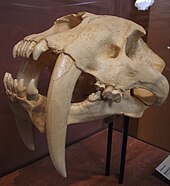Smilodon
| Smilodon | ||||||||||||
|---|---|---|---|---|---|---|---|---|---|---|---|---|

Live reconstruction of Smilodon fatalis |
||||||||||||
| Temporal occurrence | ||||||||||||
| Upper Pliocene to Late Pleistocene | ||||||||||||
| 2.588 million years to 12,000 years | ||||||||||||
| Locations | ||||||||||||
|
||||||||||||
| Systematics | ||||||||||||
|
||||||||||||
| Scientific name | ||||||||||||
| Smilodon | ||||||||||||
| Lund , 1842 | ||||||||||||
| species | ||||||||||||
|
||||||||||||
Smilodon ( old Gr . Σμίλη smílē "chisel" and ὀδούς odū́s "tooth") is a genus of extinct saber-toothed cats (Machairodontinae) that waswidespreadin America during the Pleistocene . Within the genus, Smilodon gracilis , Smilodon populator and Smilodon fatalis are three species that differ significantly in their size and other characteristics. Smilodon died out about 12,000 years ago at the turn of the Pleistocene to the Holocene .
The three species of Smilodon are also known as saber-toothed tigers because of their size and their position in the food pyramid , although they are not closely related to the tiger . Instead, Smilodon differs significantly from the big cats living today in phylogeny and anatomy .
Appearance

In terms of overall appearance , Smilodon may have been reminiscent of today's big cat, but differed from them in some characteristic features. With its sloping back, short legs and extremely powerful shoulder and neck area, Smilodon was a bit smaller, but much more muscular and heavier than today's big cats . The largest representatives of the genus reached an estimated 300 kg and were therefore heavier than today's lions and tigers , only large male Amur tigers come in this order of magnitude. For an individual from the Late Pleistocene Dolores Formation from southern Uruguay, based on the enormous skull, a weight of over 400 kg is assumed. The short stubby tail and long saber teeth that protruded up to 20 cm from the jaw were characteristic. These giant canines were not nearly circular, but oval, which made it easier to penetrate the victim's flesh.
species

Although a number of different species of Smilodon have been described throughout the history of research , only three species are generally recognized today. S. gracilis ( Latin gracilis , “narrow, slight”), the smallest species, was about the size of a jaguar at 55 to 100 kg and lived around 2,500,000 to 500,000 years ago. It probably emerged directly from Megantereon and is best known for finds from the eastern United States . The two later species S. populator (populator - looters, destroyers) and S. fatalis (fatalis - fateful) probably emerged from S. gracilis . Both died out about 12,000 years ago.
The South American saber-toothed cat S. populator lived in the eastern areas of South America and was the largest saber-toothed cat. She reached a weight of 220-360 kg and a shoulder height of about 1.2 m. The up to 28 cm long canines protruded about 17 cm from the upper jaw.
S. fatalis lived in North America and the Pacific parts of South America . This species was in size between the other two species and weighed around 160-280 kg with a shoulder height of around one meter. It differs from Smilodon populator in some essential features of the skull and proportions . The distribution areas of S. populator in the east and S. fatalis in the west were separated by the Andes . Occasionally S. californicus and S. floridanus are also listed as separate species. However, they are mostly considered subspecies of S. fatalis .
Finds and distribution
The most famous sites of S. fatalis are near Rancho La Brea in what is now California , where more than 160,000 bones of the species have been found and identified. Numerous other remains of this genus have been found in many parts of North and South America, such as Florida and Patagonia . In North America their distribution area was limited to the southern areas. Further north, the related genus Homotherium occurred at the same time in North America , the range of which in the south overlapped somewhat with that of the Smilodon . In contrast to the Homotherium , Smilodon never penetrated as far as Eurasia .
Way of life
Much can be reconstructed about the smilodon from the countless remains recovered from the tar pits at Rancho La Brea, California . From these bone finds, scientists even succeed in drawing conclusions about the way of life and social behavior of the animals. 5000 of the 160,000 remains of bones from Rancho La Brea showed severe disease features. These ranged from misalignment of the hip to broken spine and deformed leg bones. Apparently, her body was often exposed to severe stress, which probably came from fighting with extremely defensive prey. Amazingly, many of these bones showed signs of healing, even if the injuries were so severe that the animals were certainly unfit for hunting. The animals had apparently lived on for months or years. This suggests that smilodonts were organized in social groups and provided each other with food or at least tolerated group members at the crack .
The cat's likely range of prey is controversial. The long canines and the massive shape suggest that they fed on particularly large, clumsy animals such as mammoths and the American mastodon . They could have climbed onto the backs of the giant animals to dig their teeth into or tore their flanks open from the ground. Critics point out, however, that the long canines hit bones in combat and could then have easily broken. For faster animals like horses and deer , smilodonts were certainly too cumbersome. It is therefore most likely that they mainly attacked young and adolescent proboscis and giant sloths by surprising them on excursions away from the herd or by causing confusion in the herd and then quickly striking. A similar hunting behavior is suspected for the second American saber-toothed cat Homotherium , in which this assumption is supported by special fossil finds from the Texan Friesenhahn Cave.
die out
The extinction of the smilodon is mostly attributed to the disappearance of the Ice Age megafauna at the end of the Pleistocene. It disappeared about 10,000 radiocarbon years ago (equivalent to about 12,000 calendar years), along with a number of large animal forms at the end of the Pleistocene. Due to the disappearance of large prey, it was probably robbed of its livelihood and also died out. For millions of years, modern big cats ( Panthera ) and saber-toothed cats have lived side by side without seriously affecting each other. According to a theory that came to be known as the overkill hypothesis , the disappearance of large mammals at the end of the Pleistocene was largely due to human influences.
Systematics
|
Internal systematics of the Machairodontinae according to Piras et al. 2018
|
The genus Smilodon was scientifically described in 1842 by the Danish naturalist and paleontologist Peter Wilhelm Lund . The Smilodon populator fossils he describes came from a cave near the Brazilian city of Lagoa Santa , Minas Gerais . It is classified in the saber-toothed cats (Machairodontinae) within the cats (Felidae).
With the first description of the genus Rhizosmilodon in 2013, a current phylogenetic assignment of the known sawtooth cats was carried out from an analysis of a matrix of characteristics. Rhizosmilodon was due to the existing features on the basis of the tribe Smilodontini arranged and a taxon consisting of the genera Smilodon and Megantereon compared. With an age of around 5 million years, the Rhizosmilodon fossils are also the oldest fossils of the tribe. This development would mean an origin for the emergence of the Smilodontini tribe and the genera in North America, where all three genera were able to develop, as well as a later one Immigration from Megantereon to Eurasia and Africa.
In addition to the hypothesis preferred by the authors , according to which rhizosmilodon faces a common taxon of smilodon and megantereon as a sister species, they represent an alternative assumption in which rhizosmilodon and smilodon form a common taxon and megantereon faces this. The formation of the lower jaw indentation and the imperforate canines could stand for such a hypothesis. In this case, the emergence of the Smilodontini tribe with Megantereon as the most original genus in Eurasia or Africa and a double immigration to North America would be probable.
literature
- Miles Barton: Wild America. Witnesses to the Ice Age. Vgs, Cologne 2003, ISBN 3-8025-1558-7 .
- Alan Turner, Mauricio Antón: The big cats and their fossil relatives. An illustrated guide to their evolution and natural history. Columbia University Press, New York NY 1997, ISBN 0-231-10229-1 .
- Dick Mol, Wilrie van Logchem, Kees van Hooijdonk, Remie Bakker: The Saber-Toothed Cat of the North Sea. DrukWare, Norg 2008, ISBN 978-90-78707-04-2 .
- Tim Haines: In the realm of primeval times - The heirs of the dinosaurs. (Six-part BBC documentary).
Web links
Individual evidence
- ↑ Aldo Manzuetti, Daniel Perea, Washington Jones, Martín Ubilla, Andrés Rinderknecht: An extremely large saber-tooth cat skull from Uruguay (late Pleistocene – early Holocene, Dolores Formation): body size and paleobiological implications. In: Alcheringa: An Australasian Journal of Palaeontology. , 2020, doi: 10.1080 / 03115518.2019.1701080 .
- ↑ a b c Steven C. Wallace, Richard C. Hulbert Jr .: A New Machairodont from the Palmetto Fauna (Early Pliocene) of Florida, with Comments on the Origin of the Smilodontini (Mammalia, Carnivora, Felidae). In: PLoS One. Volume 8 (3), 2013: e56173. doi : 10.1371 / journal.pone.0056173 .
- ↑ a b c Per Christiansen, John M. Harris: Body Size of Smilodon (Mammalia: Felidae). In: Journal of Morphology . Volume 266, 2005. pp. 369-384.
- ↑ C. Sandom, S. Faurby, B. Sandel, J.-C. Svenning: Global late Quaternary megafauna extinctions linked to humans, not climate change. In: Proceedings of the Royal Society B: Biological Sciences. Volume 281, 2014, p. 20133254, doi : 10.1098 / rspb.2013.3254 .
- ↑ Paolo Pirasa, Daniele Silvestro, Francesco Carotenuto, Silvia Castiglione, Anastassios Kotsakis, Leonardo Maiorino, Marina Melchionna, Alessandro Mondanaro, Gabriele Sansalone, Carmela Serio, Veronica Anna Vero, Pasquale Raia: Evolution of the sabertooth mandible: A deadly ecomorphological specialization. In: Palaeogeography, Palaeoclimatology, Palaeoecology. Volume 496, 2018, pp. 166–174, doi: 10.1016 / j.palaeo.2018.01.034 .
- ↑ D. Ascanio, R. Rincón: A first record of the Pleistocene saber-toothed cat Smilodon populator Lund, 1842 (Carnivora: Felidae: Machairodontinae) from Venezuela. In: Ameghiniana. Volume 43 (2), 2006.

